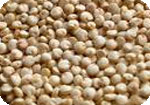| Wednesday, 14 May 2025 Home • About Us • Contact Us |
|
|
|
You are here:
Quinoa is a versatile, amino-acid packed food that is highly nutritious and has many health benefits.
Quinoa (pronounced keen-wa) is often though of as a grain, but is in fact the seed of a dark green leafy plant (Chenopodium quinoa), closely related to chard and spinach. quinoa is available in different colors, from pale yellow (the most popular) to red, brown and black. The grain is soft and creamy, but also has a slightly crunchy, nutty texture. Quinoa is a complete protein, which means that it contains all eight amino acids, an extremely rare quality in plants; it is especially high in the amino acids lysine, methionine and cysteine. Quinoa contains more protein than any other grain, and by adding it to other grains, those proteins become complete too. Quinoa is rich in iron, potassium, riboflavin, niacin, zinc, magnesium, fiber, vitamin B6 and the antioxidant Vitamin E. It also contains at least sixteen different triterpine saponins (naturally-occurring chemical compounds with 'soap-like' properties), which may have anticancer and anti-inflammatory properties. A study also found that compared to rice and wheat, quinoa was found to offer greater satiety, thus making it an ideal food for fighting obesity [1]. Preparing Quinoa
References
Link to this article: Show: HTML Link • Full Link • Short Link
Related Articles: Add a Comment You must be registered and logged in to comment. |
|
 |
 | |
|
|








